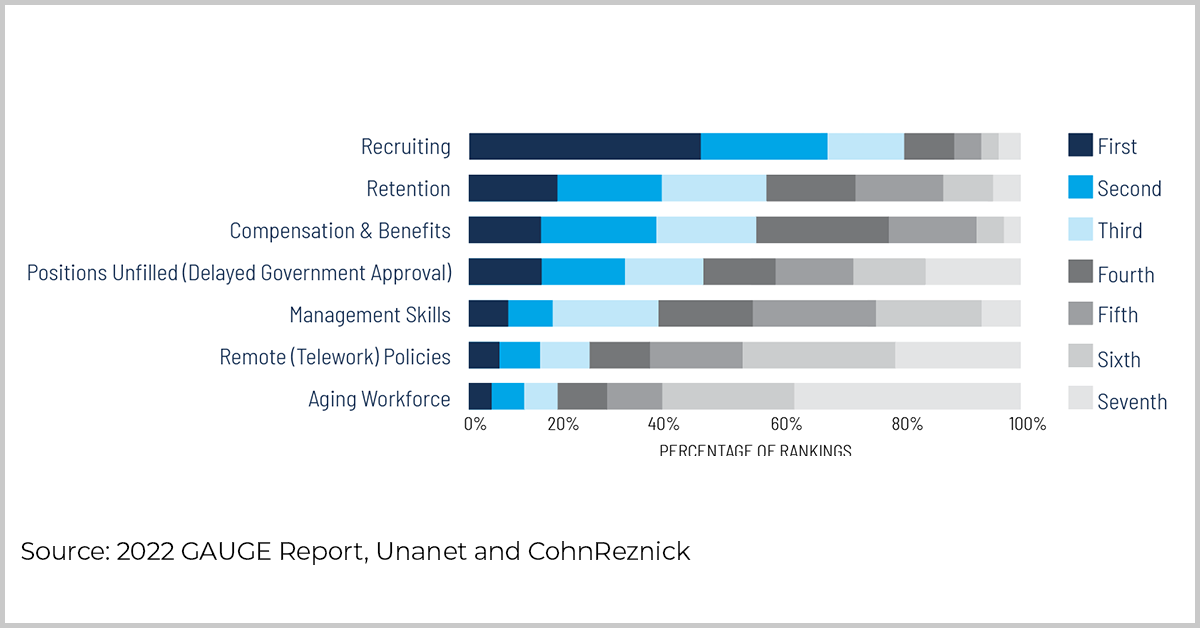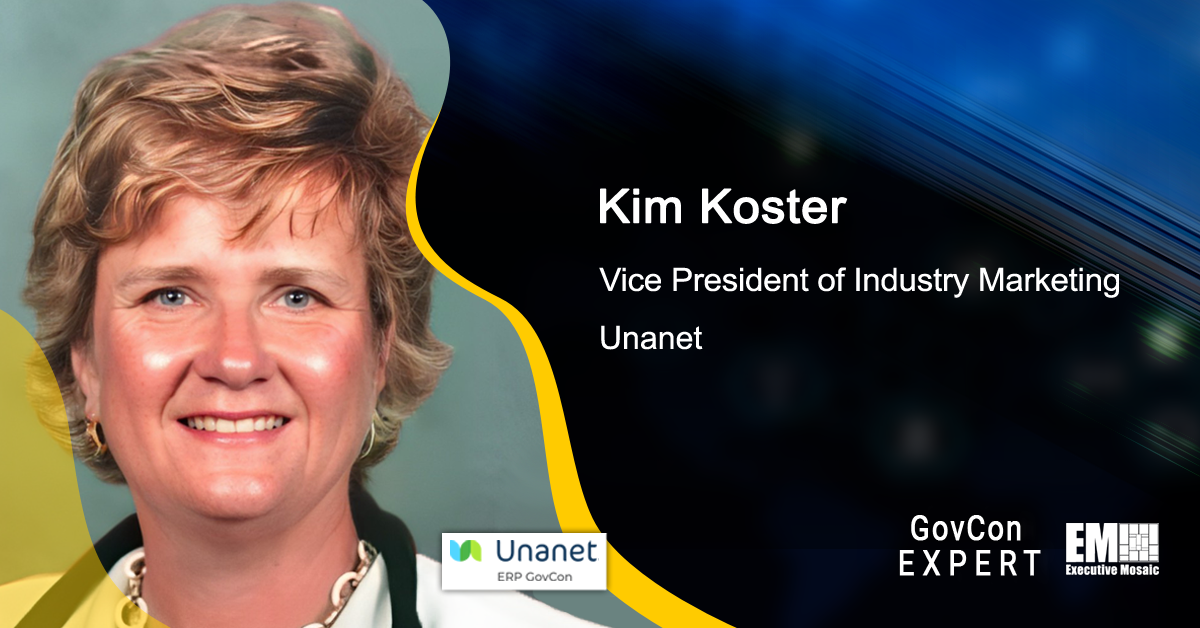by Kim Koster, VP of Industry Marketing at Unanet
As the old project management adage goes, the success of a professional services contract depends on having the right people on the right job, at the right time. As simple as that proposition may seem, firms that have actually managed a service contract know all too well it’s easier said than done.
At the crux of services contracts are people. So just hire enough of them, right? Well, not exactly. As we found in the 2022 GAUGE Report, the annual GovCon benchmarking study from Unanet and CohnReznick (available for free download here), firms on the whole consider recruitment their biggest HR challenge. Also in the GAUGE Report, government contracting firms identified resource management as their biggest project management challenge (see the graphic below). By putting recruiting and managing resources at the top of their list of challenges, firms are essentially telling us just how difficult it can be to manage people-related issues in the context of professional services projects. As firms that have experience with professional services contracts will attest, these projects often move fast. To further complicate matters, the average project manager may have up to five projects on their plate at once. Simultaneously managing planning, scheduling, overseeing work and client communications across multiple projects can be quite a balancing act.
Project Management Challenges

Sometimes the speed and complexity of a particular project can get the best of a firm. When they do, issues like schedule delays, budget overruns and scope creep can derail a project.
How, then, can firms efficiently manage resources to keep their professional services projects on track and their contracts in the black? One critical initial step is to gain a clear understanding of where exactly things went wrong with a past project or projects — common threads that, if addressed, would consistently yield positive project outcomes.
A lack of clarity is one such thread. Communicating clearly, thoroughly and in a timely way can sometimes be tricky for project managers. A lack of clarity between a PM and a customer and within a project team, about what’s in a contract in terms of requirements and scope can lead to schedule slips, cost overruns and a very disappointed customer. That can be remedied with proactive communication. It’s a small investment of time with lasting returns. When a project manager works directly with the customer to understand the contract and help shape the requirements at the outset of a project, then conveys relevant information back to their project team, that can make all the difference. A PM who has a deep understanding of customer needs is better equipped to communicate effectively internally, ensuring team members understand the contract and what’s required to deliver optimal results.
The big takeaway here is to stay in frequent contact with your customer to develop a rapport. If there are questions about the contract, don’t be shy about promptly reaching out to the customer to get the clarity you need.
Having a deep understanding of the scope of a contract is also critical to the success of a project. You want to be sure project managers and their teams understand the full scope of work a project entails, from outlining deliverables to determining deadlines. Also be sure to review the contract, in case certain details differ from what’s in the original proposal. A project manager’s comprehension of scope at the proposal stage ensures the price and schedule are reasonable and realistic. However, if they aren’t also clear on all scope details inside an executed contract, the risk of scope creep increases.
As much as we want to please the customer and let them know we’ll go the extra mile for them, the reality is that work performed outside the contract is rarely reimbursable. Scope creep is a big threat to the success of a professional services contract because it can force schedules to slip, create friction between teams and diminish the quality of the service being performed. It can also take a bite out of project profitability. Here’s another area where communication between PMs and contracts teams is critical to clarifying issues around scope. Once you have clarity internally, then you can have the scope discussion with the customer.
As GovCon firms are well aware, the talent war rages on. Hiring new employees, retaining great talent and managing resources are particularly challenging in today’s market. In fact, in the latest GAUGE Report, GovCon execs identified resource recruiting/and retention as the number one issue keeping them up at night (see the graphic below). They also told us that resource management communication is their biggest project management challenge. Open — and early — communication between functional groups and human resources departments is critical to overcoming that challenge and bringing professional services projects to a successful conclusion. They all need to understand the skills needed for project execution and when those skills will be needed. Ensuring everyone is clear about these needs at the proposal phase gives stakeholders time to plan.
Human Resources Challenges Ranked

Many of these responsibilities reside with the project manager. As the conductor and leader of a project, they’re responsible for overall execution and ensuring all stakeholders know what needs to happen and when. Fulfilling that role and effectively leading a team, require both hard and soft skills. Those skills and the project management discipline in general, are learned through experience, but they can and should be augmented and refined via project manager training.
Besides a leadership skillset, project managers and their teams also need modern tools to effectively do their jobs. Surprisingly, the GAUGE Report found that even in 2023, many firms still rely on email and error-prone, easily changed and siloed spreadsheets to manage projects. The bottom line: you don’t want to be a firm that’s data rich but knowledge poor. To turn data into insight, we see firms using analytics tools to track key performance indicators and make detailed reporting a simple exercise when it’s required. For example, firms that use data to track opportunities, probability of win, rate trends and other metrics (with the help of a solid customer relationship management system) give themselves a big competitive edge, not only in winning new business, but also in keeping compliance costs reasonable, maintaining adequate personnel levels and managing budget constraints.
When all these pieces are in place and aligned, a professional services contract stands a much better chance of delivering a positive outcome for the contracting firm and customer alike.
Without that alignment, the risk of failure is very real.



